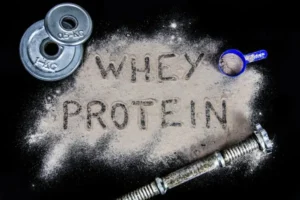Table of Contents
Whey Protein Decoded: Science, Myths, and Optimal Usage Strategies
Introduction: The Dual Nature of Whey Protein
While whey protein is celebrated in fitness circles, emerging research reveals complexities often overlooked in mainstream discussions. This analysis goes beyond conventional wisdom to explore:
- Novel applications in metabolic health
- Controversies surrounding processing methods
- Underrated synergistic nutrient combinations
- Emerging concerns about overconsumption

Whey Protein: Beyond Muscle Building – Science-Backed Benefits & Controversies
What Exactly Is Whey Protein? A Biochemical Perspective
The Cheese-Making Byproduct With Superfood Potential
Contrary to popular belief, whey isn’t simply “leftover” liquid from cheese production. Modern chromatography reveals it contains:
- Bioactive peptides with hormone-like effects
- Immunoglobulins that modulate gut immunity
- Lactoferrin with antiviral properties
The Three Faces of Commercial Whey
| Type | Processing Level | Key Differentiator | Bioavailability |
|---|---|---|---|
| Concentrate | Minimal | Retains milk lipids and lactoferrin | 85-89% |
| Isolate | Moderate | Low lactose, possible protein denaturation | 90-94% |
| Hydrolysate | Extensive | Predigested peptides, fastest absorption | 95-99% |
Controversial Insight: The common belief that hydrolysates are superior is challenged by research showing slower-digesting proteins may provide prolonged amino acid delivery.
Nutritional Breakdown: What 30g of Premium Whey Really Delivers
Macronutrient Profile
- Calories: 113-120 kcal
- Protein: 24-27g (varies by brand)
- BCAAs: 5.5-6g (leucine-rich)
Underrated Micronutrients
Most analyses overlook whey’s mineral content:
- Calcium: 8% DV (enhanced absorption vs. supplements)
- Zinc: 10% DV (critical for immune function)
- Selenium: 14% DV (powerful antioxidant)
Pro Tip: Combine whey with vitamin C-rich foods to boost iron absorption from plant sources – a strategy validated by Harvard Medical School.
9 Evidence-Based Benefits With Nuanced Interpretations
1. Muscle Protein Synthesis: Not Just for Bodybuilders
While known for building muscle, whey’s leucine threshold (2.5g per serving) triggers mTOR pathways that also:
- Preserve muscle during weight loss (critical for metabolic health)
- Reduce sarcopenia risk in aging populations
- Accelerate recovery from injuries/surgeries
4. Blood Sugar Regulation: The Timing Paradox
Studies show pre-meal whey consumption can lower postprandial glucose spikes by 28-37%. However, The American Diabetes Association cautions that:
- Effects diminish with chronic use
- Individual responses vary based on gut microbiota
- Whole-food proteins may offer longer-term benefits
7. Immune Modulation: The Gut Connection
Whey’s immunoglobulins (IgG) and lactoferrin:
- Enhance gut barrier function
- Modulate inflammatory cytokines
- May reduce respiratory infection risk in athletes
Caution: These benefits are most pronounced in grass-fed, non-denatured whey products.
Selecting Quality Whey: Beyond Marketing Hype
7 Must-Check Label Claims
- Grass-fed certification (higher CLA and omega-3s)
- Cold-processed (preserves protein structure)
- rBGH-free (no synthetic growth hormones)
- Heavy metal tested (third-party verification)
- Non-GMO project verified
- No proprietary blends (exact doses disclosed)
- Digestive enzymes included (helps lactose-sensitive users)
The A2 Protein Advantage
Emerging evidence suggests A2 beta-casein (found in heritage breed cows) may:
- Reduce gastrointestinal inflammation
- Lower histamine responses
- Improve nutrient absorption
Innovative Usage Protocols
Beyond Post-Workout Shakes
Metabolic Hack: Consume 20g whey 30 minutes before high-carb meals to blunt glucose spikes. This leverages whey’s incretin effect.
Synergistic Combinations
| Goal | Ideal Combination | Mechanism |
|---|---|---|
| Muscle Growth | Whey + Creatine + Tart Cherry | Enhances protein synthesis and recovery |
| Fat Loss | Whey + Green Tea Extract + Fiber | Increases thermogenesis and satiety |
| Longevity | Whey + Collagen + Turmeric | Supports connective tissue and reduces inflammation |
Potential Risks: The Dark Side of Protein Powders
Overlooked Concerns
- Kidney stress in those with pre-existing conditions
- Heavy metal accumulation from low-quality products
- Hormonal disruption from xenoestrogens in packaging
Who Should Avoid Whey?
According to Mayo Clinic research, contraindications include:
- Casein allergy (cross-reactivity risk)
- Histamine intolerance
- Active kidney disease
- Certain autoimmune conditions
FAQ: Addressing Consumer Concerns
Does Whey Cause Acne?
Emerging dermatological research indicates:
- IGF-1 in dairy may exacerbate acne vulgaris
- Whey isolate appears less problematic than concentrate
- Individual sensitivity varies significantly
Plant Protein vs. Whey
While plant proteins have improved, whey still offers:
- Superior PDCAAS score (1.0 vs. 0.6-0.8 for plants)
- Faster absorption kinetics
- More complete amino acid profile
Conclusion: A Balanced Approach
Whey protein represents a powerful nutritional tool when:
- Sourced from high-quality producers
- Used strategically (not as a meal replacement)
- Tailored to individual health status
For most healthy adults, 20-40g daily appears optimal, preferably cycled with whole-food protein sources to maintain metabolic flexibility.